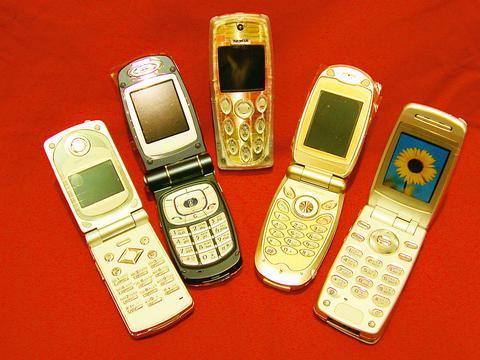Over the past six months, camera phones that send soundbytes, text and pictures via Multi Media Messaging (MMS) have become a top seller with young people in Taipei, according to staff at Asiaworld's Fnac, on Nanjing East Road.
Both men and women like the devices and the reason is that they're not just a gimmick. Sure, it's cool to take a picture when on holiday and send it to friends at home, but the camera phone already has uses in "vertical markets," where builders send photos to their supervisors and real-estate agents beam images of new homes on the market to the screens of their prospective purchasers. Even X-rays can be sent. One prediction is that there will be 100 million camera phones on the market within two years.

PHOTO: JULES QUARTLY, TAIPEI TIMES
The outlook is certainly bright for the camera-phone market, but the full picture at present must account for the blurry, 0.1-megapixel quality images common to most of the devices now. Things can only get better, but for those itching to buy one immediately, the following are five of the best options on the market.
Weighing in at a light 81g and costing NT$10,000 is the OKWAP A265 from Taiwan, which has a sleek shape and feel and a pleasing silver finish. Clean lines, compact and convenient, my only quibble with it was the odd buttons. I didn't know quite where to put my fingers. The sales lady at Fnac said this model was one of the best-selling products in the store.
The OKWAP is loaded with features -- you can download games, add a Chinese-English dictionary, connect with a computer and download files. It has a Wireless Application Protocol, or WAP, browser and can MMS. There are also downloadable logos and ring tones and even a seven-color incoming call indicator. As well as a 110K resolution digital camera with zoom function.
This was the one of the cheapest and best-appointed camera phones of the lot. The only gripe would be the size of the screen, which was half the size of most of the others.
The black or silver LG G7100 from South Korea is a different kind of beast, coming in at NT$18,900. It has large buttons, a flush design and the camera lens in the swivel of the flip phone. It tips the scales at 91g and has a swiveling panel screen that rotates 180o. It can download Java games and ring tones and also has an Internet kit provided in its bundled software. Its best feature, though, is a built-in flash, which helps overcome the common problem of too little light for camera phones. Just don't expect heroics of the flash, it works best at about 30cm. I recently saw someone use this camera phone at a nightclub to take a picture of the DJ. It was quite sad, he kept taking the photo, the flash went off, and then he would look at the image, shake his head and do it again.
This model has some nice design features, but the camera mode is a bit clumsy to operate.
Mobile-phone leader Nokia has clearly seen another market niche that needs filling, with its weird-looking translucent machine, the cheap and magnificently developed Nokia 3200. The rules of ergonomics have clearly dictated the design of this camera phone, which means it has fewer buttons that do more things. It's compact in size and looks lighter than its 90g.
This NT$10,200 phone is packed with novel features, including a flashlight. It also has FM radio and a bundled set of earphones, a voice recorder and a micro browser for supporting JPEG images. The 0.1 megapixel camera is said by most reviewers to be one of the sharpest on the market.
Beauty is in the eye of the beholder, but this should not detract from the fact this is a quality camera phone at a low price.
Another big player in the mobile-phone market, Sony Ericsson has not been idle on the camera phone front either. Its Sony Ericsson Z600 is the biggest handset of them all in terms of size and weighs in at a chunky 110g and sells for NT$15,900.
One of the few machines with Bluetooth wireless technology, the Z600 has been designed to make messaging through a variety of mediums and connectivity to the Internet a relatively easy and fun thing to do. It has a range of covers and a midi music DJ for those times when you get stuck on the train and are inspired to think of the next chart-topping hit.
Big can be beautiful too, which makes this phone a heavy-weight contender.
Pointing to the Panasonic X88, the Fnac assistant said: "This one is for the ladies." This camera phone has a clean look, some good features and is easy to use.
At 95g, it is Bluetooth-enabled and features a WAP browser. It also comes with two batteries and two chargers -- one for work and one for home. Though it was comfortable to hold and use, the NT$23,500 price could scare off many who are attracted by its good looks.
This phone has one drawback: price.
(Camera phones for this review were provided courtesy of Fnac)

May 11 to May 18 The original Taichung Railway Station was long thought to have been completely razed. Opening on May 15, 1905, the one-story wooden structure soon outgrew its purpose and was replaced in 1917 by a grandiose, Western-style station. During construction on the third-generation station in 2017, workers discovered the service pit for the original station’s locomotive depot. A year later, a small wooden building on site was determined by historians to be the first stationmaster’s office, built around 1908. With these findings, the Taichung Railway Station Cultural Park now boasts that it has

Wooden houses wedged between concrete, crumbling brick facades with roofs gaping to the sky, and tiled art deco buildings down narrow alleyways: Taichung Central District’s (中區) aging architecture reveals both the allure and reality of the old downtown. From Indigenous settlement to capital under Qing Dynasty rule through to Japanese colonization, Taichung’s Central District holds a long and layered history. The bygone beauty of its streets once earned it the nickname “Little Kyoto.” Since the late eighties, however, the shifting of economic and government centers westward signaled a gradual decline in the area’s evolving fortunes. With the regeneration of the once

The latest Formosa poll released at the end of last month shows confidence in President William Lai (賴清德) plunged 8.1 percent, while satisfaction with the Lai administration fared worse with a drop of 8.5 percent. Those lacking confidence in Lai jumped by 6 percent and dissatisfaction in his administration spiked up 6.7 percent. Confidence in Lai is still strong at 48.6 percent, compared to 43 percent lacking confidence — but this is his worst result overall since he took office. For the first time, dissatisfaction with his administration surpassed satisfaction, 47.3 to 47.1 percent. Though statistically a tie, for most

In February of this year the Taipei Times reported on the visit of Lienchiang County Commissioner Wang Chung-ming (王忠銘) of the Chinese Nationalist Party (KMT) and a delegation to a lantern festival in Fuzhou’s Mawei District in Fujian Province. “Today, Mawei and Matsu jointly marked the lantern festival,” Wang was quoted as saying, adding that both sides “being of one people,” is a cause for joy. Wang was passing around a common claim of officials of the People’s Republic of China (PRC) and the PRC’s allies and supporters in Taiwan — KMT and the Taiwan People’s Party — and elsewhere: Taiwan and